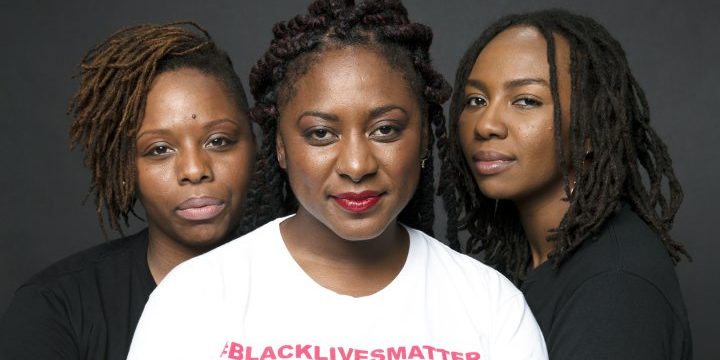The Black Lives Matter Movement: An Origin Story
Isabella Mercado, Communications Intern
Trayvon Martin. A 17-year-old Black boy murdered on February 26, 2012 while walking home from a 7-eleven in Sanford, Florida. His killer? George Zimmerman, a white man who served as coordinator of the neighborhood watch. The video of Trayvon’s murder sparked national outrage. For weeks, newspapers, television, and media outlets reported peaceful protestors flooding the streets of cities across America, shouting for the arrest and conviction of Zimmerman. Forty-five days after the death of Trayvon Martin, Zimmerman was arrested. On July 13, 2013, Zimmerman was found not guilty. Profound horror and sadness ensued. Thousands of people felt the pain of injustice at the acquittal of George Zimmerman.
Alicia Garza, a domestic worker rights organizer in Oakland, California, was particularly struck by not only the news, but the reactions that appeared on her Facebook feed. There were two main trends, which she dubbed: social justice cynicism and respectability politics. Some people were unsurprised that the system, with a long history of failure to protect Black families, would once again favor the white transgressor. Other people began justifying and excusing Zimmerman, looking to Trayvon’s family, personal life, and behaviour as the reason for his death. In response, Garza began writing a series of Facebook posts she titled, “A Love Letter to Black People.” In her final post, she wrote, “black people. I love you. I love us. Our lives matter.” Her close friend, Patrisse Cullors, an anti-police violence organizer in Los Angeles, California who she had met through the organization Black Leadership for Organizing and Dignity (BOLD), responded to the post saying “#BlackLivesMatter.” Their friend, Opal Tometi, an immigration rights worker in Phoenix, Arizona contributed her support and a movement was born.
The hashtag was slow to gain popularity. In the second half of 2013, the hashtag appeared on Twitter a total of 5, 106 times. But then on August 4, 2014, Michael Brown, an 18-year-old Black man was murdered by white police officer Darren Wilson in Ferguson, Missouri. His body was left on the ground for four hours before being taken to the city morgue. The event was documented by bystanders with cell-phones and the news spread around the world via social media. Protesters, initially localized in Ferguson, soon began to appear throughout the nation; they took to the streets just as they had done after the murder of Trayvon Martin. Garza, Cullors, and Tometi had spent the last year with the help of cultural workers, artists, designers, and technicians building the infrastructure to support “moving the hashtag from social media to the streets.” Their team grew through the Black Lives Matter Freedom Ride to St. Louis, Missouri, a plan that had been led and designed by Patrisse Cullors and Darnell L. Moore. They organized for over 500 of their members from across the nation to travel to Missouri to help participate in the protests. Cullors and Moore described their intentions in an article they wrote for the Guardian: “The BLM Ride was organized in the spirit of the early 1960s interstate Freedom Riders in the racially segregated south, after the visuals of Michael Brown’s lifeless and blood-drenched body brought to mind images of lifeless black bodies hanging from lynching trees in the all-too-recent past, after the militarized police forces looked all too similar to the response of police to protestors during the civil rights movement.” In the three weeks after Michael Brown’s death the #BlackLivesMatter hashtag was used an average of 58,747 times per day. There was another dramatic increase three months later, on November 25, the day after the Ferguson grand jury decided to not charge Darren Wilson with Brown’s murder, when the hashtag was used 172,772 times. In the subsequent three weeks, the #BlackLivesMatter hashtag appeared 1.7 million times.
The Black Lives Matter Movement was inspired by the 1960s Civil Rights Movement, the 1980s Black Feminist movement, Pan-African movement, and political hip-hop movement, and the 2000s LGTBQ+ movement. By working to end systematic racism, BLM continues the efforts of 19th century organizations including but not limited to: the American League of Colored Laborers, the Florence Farming and Lumber Association, and the NYS Suffrage Association. Like the Student Nonviolent Coordinating Committee (SNCC), Black Lives Matter used collective planning as they rejected the heteronormative, patriarchal heirarchy that pervades most Black rights organizations. The Black Live Matter organization patterned itself after Chicago’s Black Youth Project 100 by placing people from marginalized backgrounds into central roles. With Black women, trans, and queer members in leadership roles, Garza described how BLM differentiated itself from traditional perceptions of Black activism: “It goes beyond the narrow nationalism that can be prevalent within some Black communities, which merely call on Black people to love Black, live Black and buy Black, keeping straight cis[gendered] Black men in the front of the movement while our sisters, queer and trans and disabled folk take up roles in the background or not at all.”
The Black Lives Matter revolutionized Black activism in more ways than one. The Movement has utilized protesting strategies including disrupting national holidays (e.g. Black Friday and Christmas) and publicly challenging politicians, widespread media coverage from unique sources such as a 2015 episode in NBC’s popular show Law & Order: SVU, and public support from organizations like the N.F.L. and NASCAR to garner attention and drastically increase participation more than ever before. According to Deva Woodly, associate professor of politics at the New School, at the height of the 60’s Civil Rights Movement protests peaked at hundreds of thousands of people, but in the recent Black Lives Matter protests participation was in the millions. Support for the Black Lives Matters is unprecedented and continues to expand. We, at the Underground Railroad Education Center, stand in solidarity with the Black Lives Matter Movement as they continue to fight for an equitable and just world.


